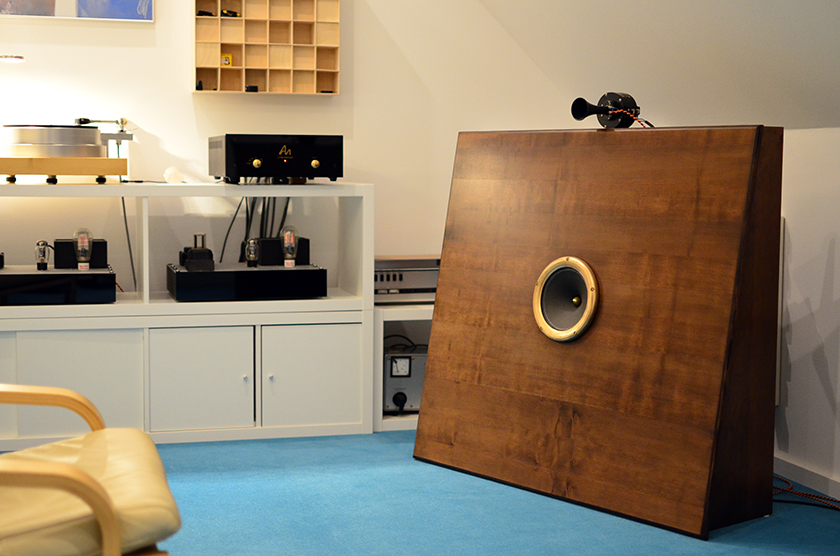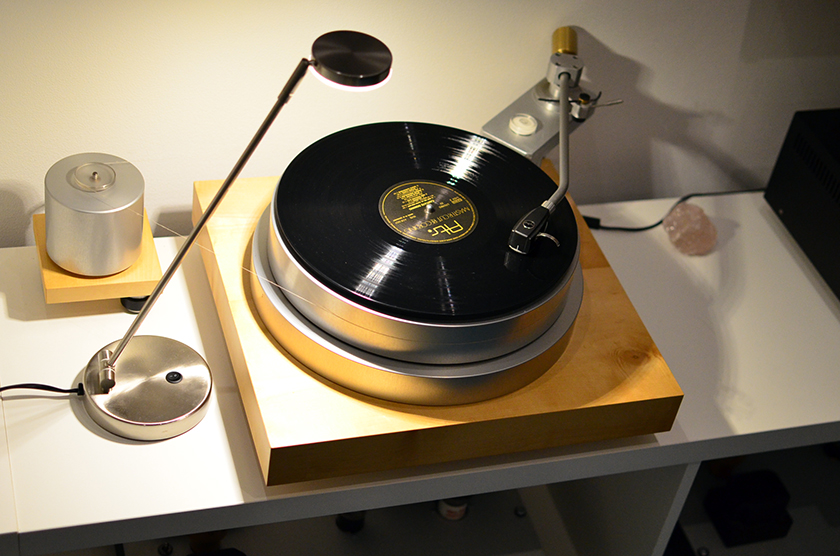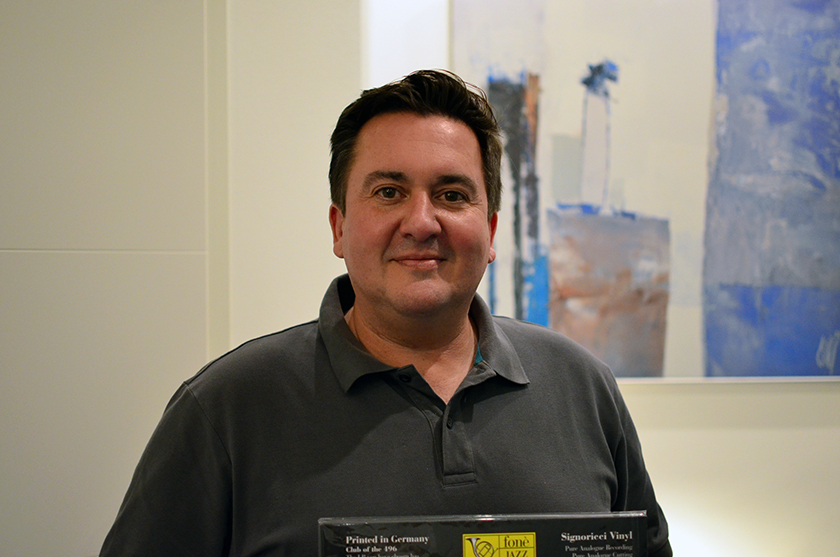I went to Kassel over the weekend guys, just for the sake of meeting Michael Methe and his buddy Martin Bober as well as to listen to their systems. For those of you who have never heard of Michael I just want to say that he is very special for me and his blog was the main inspiration to get into blogging myself. He is pretty well known in the audio circles here in Germany and his website is a database of very well documented DIY projects, customization of commercial products and experiences in the realm of audio reproduction. Following his winding road in chasing the perfect sound has brought me great amounts of pleasure and has raised my level of understanding.
I took the train at 6 o’clock in the morning from Hamburg and at 9 o’clock I was in Kassel. I had two hours to stroll about the city and have breakfast before our meeting at Martin’s apartment take place. Thought it was drizzling, the old city in this Saturday morning was quite inviting. I strolled about the downtown enjoying the facades of some historical buildings and decided to have espresso in a cafe just opposite the town hall and the Hemingway club down there. Occasional people were crossing the street and trams were going but not much was happening at these early hours. After finishing my coffee I set off in the direction of our meeting point along a picturesque road above the northern bank of Fulda river. I realized how charming this city is, apart from architecture and art (Documenta art fair is hosted here and there are many galleries and objects of art scattered around) the city is built on top of an interesting landscape intersected with hills and valleys. Its southern slopes are planted with vineyards and there are several parks covered with rusty colors now in the late autumn. It was really a joy for my sight to contemplate a landscape that is so different than the flat plain of north Germany where I reside. I could hardly resist the urge to start climbing one of the nearby hills, but the time was advancing so I just had a breakfast in a nearby bakery.
At the appointed time I was ringing on the Martin’s doorbell and he accepted me shortly after with a broad smile and very inviting look. Martin is a hardcore Quad lover and his system consists of Quad ESL 57 electrostatic loudspeakers driven by Quad II Classic tube power amps and Quad QC-24 preamplifier. The front-end consisted of Thorens TD 124 turntable with Denon DL103 cartridge mounted on converted by Volker Heinze SME 3012 tonearm. I was so taken by the performance of this system and the charm of Martin’s character that I decided not to disturb this magical experience with routine things like taking photos or asking stupid questions. It was my first encounter with these iconic speakers and what I can say for sure is that they really impressed me. In fact their open and clean sound made me realise how colored my back-loaded horns sound. The imaging of these electrostatic speakers is also very special, I would say holographic – the focus seems to aim toward infinity so every instrument, even when it is located in the periphery, is very well outlined. I have never experienced such imaging with cone radiators which usually focus on the soloing instruments in the middle – like when you use wide aperture setting applied to a camera while focusing on a nearby object – the objects at the sides and the background are blurred. It looks like the flat diaphragm of the electrostats projects sonic images differently than the cone of the direct radiator.
I really enjoyed the ESL 57’s transparency and pure tone combined with great imaging that the old Thorens TD 124 picked up from some Deutsche Grammophon pressings of Schubert piano sonatas. But at the end, however good these speakers are, they too have deficiencies – the main one being their limited dynamic capabilities – the range from the softest to the loudest sound does not quite match this of a good direct radiator or horn speaker. The bass is quite shy as well and the sweet spot is about the narrowest I have ever encountered, but despite of this these speakers are sheer joy to listen. Especially noticeable was their ability to perform absolutely unrestrained and free from any baffle/enclosure colorations – this made listening very easy and I realized that I can listen to them for hours and hours without the slightest touch of fatigue. It is the most relaxed listening I’ve ever experienced, really a pleasure.

After making a break and having a lunch we set off for Michael’s place in the nearby village of Espenau – really nice spot on earth, enclosed by forest covered hills. Michael’s new house is cosy and spacious on the ground level with big french windows and plenty of natural light. The interior is modern and stylish, built with love and minimalist nordic composure. His professional coffee machine and his passion for good coffee contributed further for our collective comfort. His listening room on the top floor presents quite some challenge in terms of space with its oblong shape and area of around 18 square meters.
Over the last 35 years Michael went through extremely vast variety of speaker concepts – electrostatic, magnetostatic, open baffle, ported and sealed box, horns, different DIY and commercial designs but in the last few years he settled with slightly modified version of the open baffle speakers featured in the Japanese magazine Stereo Sound in 1996 fitted with 8″ PHY-HP full-range drivers. These baffles are augmented in the low registers with an Neumann KH 805 active studio subwoofer and in the heights with Line Magnetic 597 field coil tweeters. The speakers are driven by DIY 300B monoblocks based upon modified JE Labs 300B SE circuit. The main source is analog as you might guess – a customized Acoustic Signature turntable with Ortofon SPU cartridge mounted on 12″ tonearm from Michael Wiedemann. Auditorium 23 step-up transformer and Audio Note L2 Phono line preamplifier complement the setup.

I don’t have much experience with open baffle speakers, just a few encounters on audio shows, and my impressions of them are mixed bag – at one point there is a seductive openness but on the other the tone lacks density and weight in the midrange and lower registers. But Michael’s OB speakers are different from these I heard before – the most obvious difference being the landscape aspect ratio of the baffle sizes as opposed to the vastly adopted portrait one. In comparison to what I’ve heard before, even with the subwoofer switched off, these speakers deliver full and mature bass performance and I was really unable to say if the woofer works or not. As Michael told me the woofer is crossed at around 40 Hz and it is rolled off a bit so that his contribution to the overall sound should be very subtle. We started our session with Enzo Pietropaoli’s Solo album which features double bass only and I was smitten by the articulation and the energy in the low registers, it is quite astonishing what these 8″ PHY-HP drivers deliver out of them open baffles. Spatial clues were rendered extremely believable so I instantly felt being there – in the hall where the performance took place.
The only weird thing about this setup is that because of the space limitations the listening seat is located around 2 meters away from the speakers, which makes the situation I would say near-field. I mean the speakers are not small at all and when listening to them from such a short distance I am submerged in great amount of details which makes the experience a bit hard on the ears, especially by increased loudness. But all this is very subjective and a matter of preference. I just like to keep perspective rather to be immersed in the sound field, to enjoy and contemplate the self-sustained presence of the soundstage from a distance. Usually this is what I get from live performances – I am listening from a distance to what is going on on the stage, the sound have direction and the sources could be localized meters ahead. With Methe’s setup I had the feeling that I am on the stage and the instruments are within a reach, something that might be thrilling for someone but not for me – I am just this type of voyeur listener who likes to observe things from a distance while staying safely in the shadow.
So in situation like this I would have rather picked some bonsai speakers and tried to create a compact but lively and self-sustained soundstage to enjoy from a distance. It is just the way it is – the room determines the speaker choice – not the other way around. But in spite of my different attitudes I was able to discern a level of performance high above the average and even if the limited space did not allowed me to enjoy the full potential of the system – its sheer dynamic prowess and resolving capabilities were quite a statement. Another thing I like is the simplicity of such single-driver open baffle concept. Even with the subwoofer and twitters switched off the speakers sounded complete and full-bodied so that I was not able to tell any difference, so subtle these extensions are, or so deaf am I 🙂
Later on Michael told me that many years ago he also thought like me and preferred far-field listening but with the time his preferences shifted toward the quasi-near-field listening because of the more detailed and involving presentation. He mentioned also that the quasi-near-field situation blends out part of the room influence by altering the ratio between direct and reflected sound waves at listening position. Having this in mind he planned his new listening room especially for that purpose with the help of two acoustic specialists and according to him the result is just what he dreamed of.

At the end I would say that Michael’s biggest achievement is the fact that despite of his full dedication to the audiophile hobby he managed to keep the balance and not ruin his family life. Just the opposite, together with his wife Patricia they have built a new home where in spite of certain compromises he has his space where along with reading he could practice his favorite hobby – listening to music. He confessed to me that at least few people he knows has been divorced in the recent years not because of anything else but because of their uncontrollable dedication to the music listening and the accompanying assembly of an audio system capable of reproducing the subtlest nuances of the performance captured in the record. It is sad in a way that something as beautiful as the music and its reproduction could lead to such complications, but at the end the listening is a lone act and one don’t need another to share the listening experience.
The amount of time spent on this seductive activity is often crucial when it comes down to human relationships. There are not just few cases when uncontrollable personal tendencies and collective interests collide resulting in breaking the bond of the life together. I wish you all dear fellows to keep sanity and don’t let the audiophile bug to push you off the track of the normal life.
Thank you for stopping by and always happy listening!
